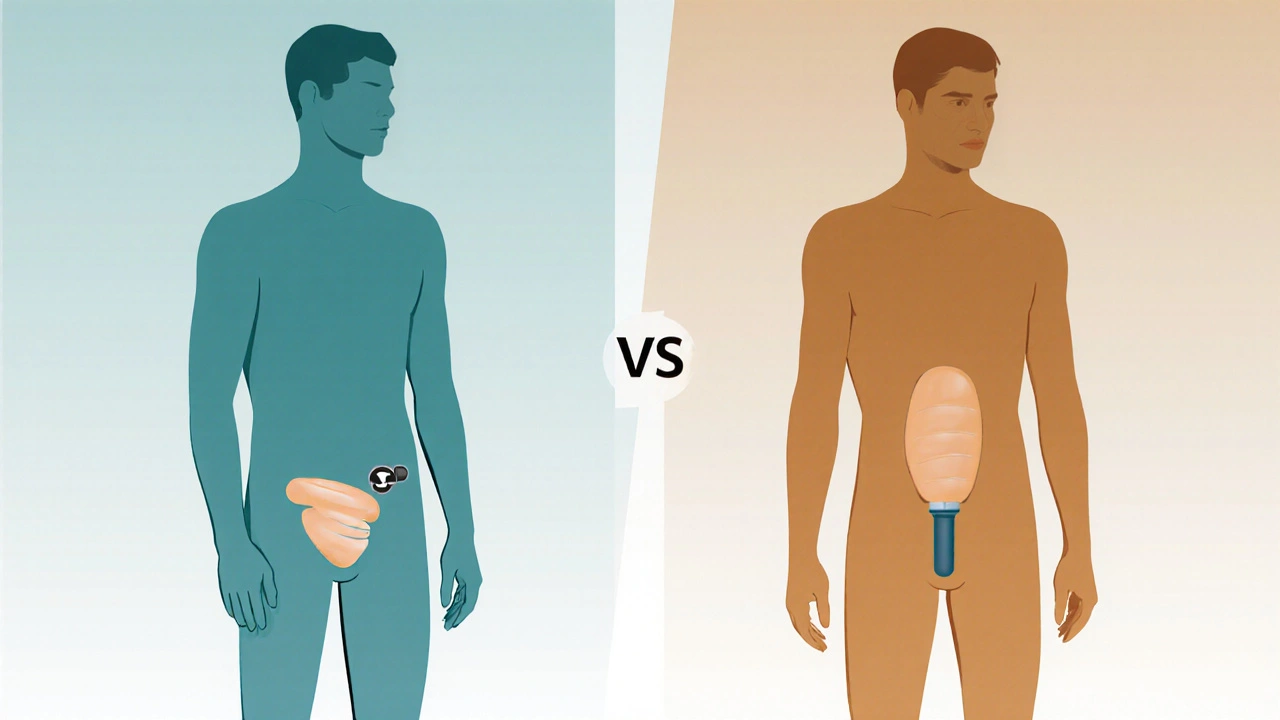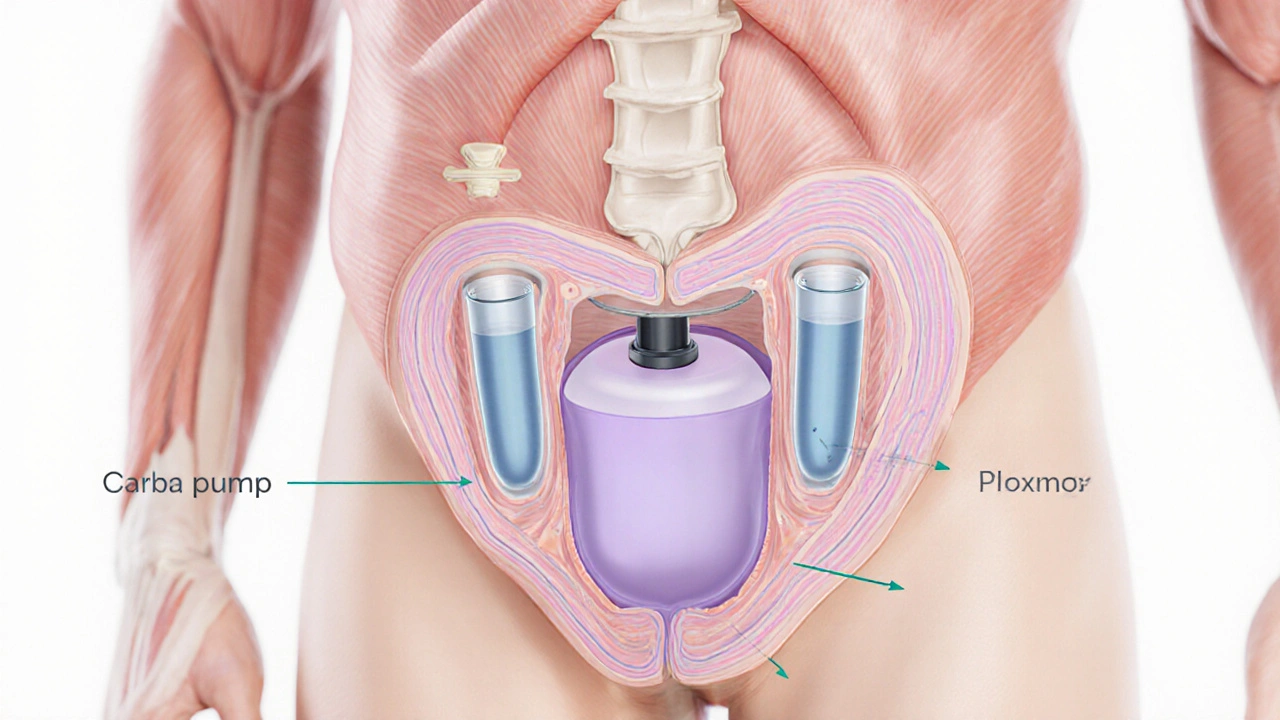Penile Implant Comparison Tool
Pros: Natural appearance when flaccid, adjustable rigidity, feels most natural during intercourse.
Cons: More complex design, higher cost, slightly higher mechanical failure risk.
Features: Two cylinders, pump in scrotum, fluid reservoir under abdomen.
Pros: Simpler design, lower cost, easier surgery, no moving parts.
Cons: Always firm appearance, less natural feeling, manual positioning required.
Features: Bendable rods that are always firm.
| Feature | Inflatable Prosthesis | Semirigid Rod |
|---|---|---|
| Appearance when flaccid | Soft, looks natural | Always firm, may feel obvious |
| Erection control | Pump activates, full rigidity on demand | Manual bending, less precise |
| Complexity | More components, higher cost | Simpler design, lower cost |
| Mechanical failure rate | ~5% over 10 years | ~2% (no pump) |
| Typical surgery time | 90-120 minutes | 45-60 minutes |
Inflatable System Risks
- Infection (1-3%)
- Mechanical failure (~5% over 10 years)
- Erosion (rare)
- Pain or numbness (usually temporary)
Semirigid Rod Risks
- Infection (1-3%)
- Mechanical failure (~2%)
- Erosion (rare)
- Pain or numbness (usually temporary)
penile implant is a surgically placed device that enables men with severe erectile dysfunction to achieve an erection. If you’ve tried pills, injections, or vacuum pumps without success, you’re probably wondering whether a permanent solution makes sense. This guide walks through the upside, the downside, and the practical steps involved, so you can decide with a clear head.
Quick Takeaways
- Implants restore firmness for 95% of men and often boost confidence.
- Infection rates sit around 1‑3% in experienced hands, but they’re the most common serious complication.
- Two main designs exist: inflatable systems that feel more natural, and semirigid rods that are simpler and cheaper.
- Recovery typically takes 4‑6 weeks; most patients resume sexual activity within two months.
- Insurance usually covers the procedure if you have documented erectile dysfunction.
Understanding Penile Implants
First, let’s demystify the term. A penile implant isn’t a one‑size‑fits‑all gadget. There are three broad categories, but today we focus on the two most common: inflatable penile prosthesis and semirigid prosthesis. Inflatable models consist of two cylinders placed in the shaft, a pump in the scrotum, and a fluid‑filled reservoir under the abdomen. When you press the pump, fluid moves into the cylinders, creating an erection that feels and looks natural. Semirigid rods are bendable but always firm; you manually position them for intercourse and conceal them under clothing.
Why Men Choose Implants
When non‑surgical options fail, the primary gain is reliable rigidity. Clinical surveys report that 90‑95% of men achieve satisfactory erections after implantation, and partner satisfaction mirrors that rate. The psychological lift is real-many report reduced anxiety, improved mood, and a revived sense of masculinity.
Beyond sexual function, implants can simplify life. No more daily pills, no timing constraints, and no need for vacuum devices. For couples dealing with performance pressure, the device removes the ‘guesswork’ and lets intimacy flow more naturally.

Risks You Can’t Ignore
Every surgery carries a price tag, and penile implants are no exception. The most cited complications are:
- infection - Occurs in roughly 1‑3% of cases when surgery is performed by an experienced surgeon. Prompt antibiotic treatment is essential; severe infections may require device removal.
- mechanical failure - Inflatable systems have moving parts; the pump or tubing can wear out over 5‑10 years, necessitating revision surgery.
- Erosion - The cylinders can press against surrounding tissue, especially if the device is oversized.
- Pain or numbness - Most resolves in weeks, but persistent discomfort should be evaluated.
While these risks sound intimidating, remember that the absolute numbers are low, and most complications are manageable with early medical attention.
Choosing the Right Type: Inflatable vs Semirigid
| Feature | Inflatable Prosthesis | Semirigid Rod |
|---|---|---|
| Appearance when flaccid | Soft, looks natural | Always firm, may feel obvious |
| Erection control | Pump activates, full rigidity on demand | Manual bending, less precise |
| Complexity | More components, higher cost | Simpler design, lower cost |
| Mechanical failure rate | ~5% over 10 years | ~2% (no pump) |
| Typical surgery time | 90‑120 minutes | 45‑60 minutes |
Inflatable systems win on natural look and feel, but they cost more and involve a slightly higher failure risk. Semirigid rods are a solid choice for men who want a budget‑friendly option or who have health conditions that make longer surgery risky.
The Surgery Journey
Preparation starts with a thorough evaluation. Your urologist will document the severity of erectile dysfunction, rule out reversible causes, and discuss expectations. Most insurers require proof that other treatments failed, so keep records of medication trials and therapy attempts.
The operation itself is performed under general or spinal anesthesia. The surgeon makes a small incision either at the base of the penis or in the lower abdomen, inserts the device, and sutures the incisions. Antibiotics are given before the skin is cut and continued for a few days after.
Recovery milestones are predictable: day‑one you’ll have a dressing and mild swelling; by week2 you can start gentle walking; at week4 you may begin light pelvic floor exercises. Full sexual activity is usually safe after 6‑8 weeks, once the incision has healed and you’ve cleared the surgeon’s checklist.
Cost varies widely. In Australia, a private health plan often covers 80‑90% of the procedure if you have a documented diagnosis. Out‑of‑pocket expenses can range from AU$10,000 to AU$20,000, including device, surgeon fees, and hospital stay.
Managing Expectations & Aftercare
Implants restore rigidity, but they don’t magically solve every intimacy issue. Communication with your partner remains crucial. Many couples find that the first few sexual encounters feel “different” as they adjust to the new mechanics.
Follow‑up visits are scheduled at 2 weeks, 6 weeks, and then annually. During these appointments, the surgeon checks for infection signs, verifies that the device functions correctly, and advises on any needed adjustments.
Lifestyle tweaks can prolong device life: avoid excessive pressure on the pelvis, maintain a healthy weight, and control diabetes if present. If the implant fails mechanically, most surgeons can perform a revision with a new device, often with minimal additional downtime.

Frequently Asked Questions
How long does a penile implant last?
Modern devices are designed for 10‑15 years of use. Inflatable systems may need a pump or cylinder replacement after about a decade, while semirigid rods often last longer because they have fewer moving parts.
Is the surgery painful?
Pain is usually mild and managed with prescribed analgesics. Most men report that discomfort subsides within a week, and any lingering soreness disappears by the time they resume normal activity.
Can I have a penile implant if I have diabetes?
Yes, diabetes is a common reason for severe erectile dysfunction, and many diabetic patients receive implants successfully. Good blood‑sugar control reduces infection risk and improves healing.
Will my partner notice the implant?
With an inflatable system, the penis looks and feels natural when flaccid, so most partners don’t notice any difference. Semirigid rods stay firm, which can be felt, but many couples adapt quickly.
What triggers an infection after surgery?
Infection usually stems from bacteria entering the surgical site, often from the skin or urinary tract. Following pre‑op cleaning protocols and post‑op antibiotic regimens dramatically cuts this risk.


Anthony MEMENTO
October 3, 2025 AT 01:29Penile implants are not just a quick fix they represent a major surgical commitment. The data on infection rates is often glossed over in mainstream articles. You really need a surgeon with a high volume of cases to keep those numbers low. Otherwise the risks climb faster than most people realize.
aishwarya venu
October 8, 2025 AT 04:41Thanks for highlighting the importance of specialist experience.
Nicole Koshen
October 13, 2025 AT 07:53The comparison chart does a decent job summarizing the key differences. I’d add that the inflatable system’s fluid reservoir can sometimes cause abdominal discomfort if not placed correctly. Also, surgeons often prefer the semirigid option for patients with significant comorbidities.
Ed Norton
October 18, 2025 AT 11:05Good point about comorbidities. I’ve seen a few cases where the simpler rod made recovery smoother.
Karen Misakyan
October 23, 2025 AT 14:17From a clinical perspective, one must consider the long‑term durability of the device. Inflatable prostheses, while aesthetically superior, entail a greater number of mechanical components susceptible to wear. In contrast, semirigid rods, despite their perpetual firmness, demonstrate a lower incidence of mechanical failure over a decade. Ultimately, the decision should be anchored in a thorough risk‑benefit analysis tailored to the patient’s lifestyle and medical history.
Amy Robbins
October 28, 2025 AT 16:29Sure, but don’t forget that many of these “expert” surgeons are just chasing prestige. The market pushes the inflatable version like it’s a status symbol, not a medical necessity.
Shriniwas Kumar
November 2, 2025 AT 19:41In the Indian context, affordability often dictates the choice, especially given the public health expenditure constraints. The semirigid model aligns well with resource‑limited settings while still delivering functional outcomes. However, there’s a cultural stigma attached to permanence that some patients find unsettling.
Jennifer Haupt
November 7, 2025 AT 22:53Absolutely, socioeconomic factors play a huge role. It’s also vital to ensure patients receive counseling to manage expectations regardless of the device type.
NANDKUMAR Kamble
November 13, 2025 AT 02:05The industry isn’t telling you about the hidden patents that drive up costs. It’s all a big cover‑up.
namrata srivastava
November 18, 2025 AT 05:17One must also scrutinize the regulatory approvals that are often expedited for profitability.
Priyanka arya
November 23, 2025 AT 08:29🔥 Wow, never thought about that angle! 🤔 The hidden fees can really bite.
Loren Kleinman
November 28, 2025 AT 11:41Penile prosthesis surgery, while offering a definitive solution for refractory erectile dysfunction, involves a cascade of pre‑operative, intra‑operative, and post‑operative considerations that merit a nuanced discourse. First, the candidacy assessment hinges upon a comprehensive evaluation of vascular integrity, neurogenic factors, and psychosocial determinants, ensuring that the underlying etiology is indeed refractory to pharmacologic and mechanical therapies. Second, the choice between inflatable and semirigid devices must be contextualized by the patient’s manual dexterity, partner preferences, and lifestyle demands; for instance, an active individual may prioritize the discreet flaccidity of an inflatable system, whereas a patient with limited hand function may derive greater benefit from the simplicity of a semirigid rod. Third, surgical expertise plays a pivotal role; high‑volume surgeons demonstrate markedly lower infection rates, often cited between 0.5‑1%, compared to the 2‑3% observed in lower‑volume settings. Fourth, the intra‑operative protocol should incorporate prophylactic broad‑spectrum antibiotics administered within an hour of incision, meticulous hemostasis, and utilization of antimicrobial‑impregnated devices when available, collectively mitigating bacterial colonization. Fifth, postoperative management encompasses wound care, gradual resumption of activity, and structured pelvic floor rehabilitation, typically commencing at four weeks to enhance device positioning and patient comfort. Sixth, the longevity of modern implants, especially inflatable models, extends beyond a decade, although mechanical failure-manifesting as pump malfunction or tubing erosion-remains a non‑negligible risk, necessitating vigilant follow‑up and readiness for revision surgery. Seventh, patient education is indispensable; couples counseling can preempt misaligned expectations, fostering mutual adaptation to the altered biomechanics of intercourse. Eighth, insurance coverage, while generally favorable for documented erectile dysfunction, often requires exhaustive documentation of prior unsuccessful interventions, underscoring the importance of meticulous record‑keeping. Ninth, ancillary considerations such as comorbid diabetes, smoking status, and obesity substantively influence wound healing trajectories and infection susceptibility, compelling clinicians to optimize systemic health pre‑operatively. Tenth, emerging technologies, including remote‑controlled inflatable devices and bio‑engineered prosthetic materials, hint at future paradigms that may further reduce complication rates. Eleventh, the psychological impact of regaining sexual function cannot be overstated; studies consistently report improved self‑esteem and relationship satisfaction post‑implantation. Twelfth, however, it is prudent to acknowledge that sexual intimacy encompasses more than mechanical erection, and ongoing communication remains paramount. Thirteenth, the decision matrix must also weigh the financial implications, as out‑of‑pocket expenses can range dramatically based on device selection and geographic location. Fourteenth, interdisciplinary collaboration-with urologists, infectious disease specialists, and physiotherapists-optimizes outcomes across the treatment continuum. Lastly, continued research and registry data collection are essential to refine best‑practice guidelines and enhance patient safety in this evolving field.
Sabrina Goethals
December 3, 2025 AT 14:53That was an impressive deep‑dive; really informative! I appreciate the thoroughness.
Sudha Srinivasan
December 8, 2025 AT 18:05People need to stop glorifying risky surgeries. Simpler options are often safer.
Jenny Spurllock
December 13, 2025 AT 21:17Interesting perspective. How do patients typically adjust psychologically?
Bart Cheever
December 19, 2025 AT 00:29Honestly, the article could have been shorter.